On the Optimisation of Practical Wireless Indoor and Outdoor Microcells Subject to QoS Constraints
Abstract
:1. Introduction
- An optimisation problem is firstly developed to minimise the number of cells subject to the constraints of the required coverage and QoS at a specific area within a WIOM network. Given the fact that the locations for deploying the cell sites are restricted, the locations of these optimal cells are also required to be determined.
- A binary-search based cell positioning (BSCP) algorithm is proposed to not only find the optimal number of cells but also their optimal location given a preset candidate antenna positions. It is shown that the proposed BSCP allows us to determine the minimal number of cells with a low computational complexity compared to the conventional approach where exhaustive searches are utilised to iteratively validate all available locations for cell sites.
- EDX SignalPro [40] is exploited as a simulation platform to verify the effectiveness of the proposed BSCP for the WIOMs. Specifically, we consider various propagation modes of both indoor and outdoor environments with different antenna types, including single-input single-output (SISO), multiple-input single-output (MISO) and multiple-input multiple-output (MIMO). The proposed method can therefore be used for planning and optimisation of the WIOMs to reduce the waste of resources in terms of cost and power consumption.
2. Related Works
3. System Model of WIOMs and Network Optimisation Problem
4. The Proposed Binary-Search Based Cell Positioning Algorithm
| Algorithm 1: BSCP Algorithm for WIOM Planning. |
Require: N, , , , :
|
5. Simulation Results and Evaluation
5.1. Wireless Indoor Microcells
5.2. Wireless Outdoor Microcells
6. Conclusions
Acknowledgments
Author Contributions
Conflicts of Interest
References
- Chih-Lin, I.; Greenstein, L.J.; Gitlin, R.D. A microcell/macrocell cellular architecture for low- and high-mobility wireless users. IEEE J. Sel. Areas Commun. 1993, 11, 885–891. [Google Scholar]
- Lagrange, X. Multitier cell design. IEEE Commun. Mag. 1997, 35, 60–64. [Google Scholar] [CrossRef]
- Hoydis, J.; Kobayashi, M.; Debbah, M. Green Small-Cell Networks. IEEE Veh. Technol. Mag. 2011, 6, 37–43. [Google Scholar] [CrossRef]
- Wang, S.; Ran, C. Rethinking cellular network planning and optimization. IEEE Wirel. Commun. 2016, 23, 118–125. [Google Scholar] [CrossRef]
- Ganz, A.; Krishna, C.; Tang, D.; Haas, Z. On optimal design of multitier wireless cellular systems. IEEE Commun. Mag. 1997, 35, 88–93. [Google Scholar] [CrossRef]
- Ekici, E.; Ersoy, C. Multi-Tier Cellular Network Dimensioning. ACM Wirel. Netw. 2001, 7, 401–411. [Google Scholar] [CrossRef]
- Andrews, J. Seven ways that HetNets are a cellular paradigm shift. IEEE Commun. Mag. 2013, 51, 136–144. [Google Scholar] [CrossRef]
- Trestian, R.; Vien, Q.-T.; Shah, P.; Mapp, G. Exploring energy consumption issues for multimedia streaming in LTE HetNet small cells. In Proceedings of the 40th IEEE Conference on Local Computer Networks (LCN), Clearwater Beach, FL, USA, 26–29 October 2015; pp. 498–501. [Google Scholar]
- Vien, Q.-T.; Le, T.A.; Barn, B.; Phan, C.V. Optimising energy efficiency of non-orthogonal multiple access for wireless backhaul in heterogeneous cloud radio access network. IET Commun. 2016, 10, 2516–2524. [Google Scholar] [CrossRef]
- Zhao, W.; Wang, S.; Wang, C.; Wu, X. Approximation Algorithms for Cell Planning in Heterogeneous Networks. IEEE Trans. Veh. Technol. 2017, 66, 1561–1572. [Google Scholar] [CrossRef]
- Vien, Q.-T.; Le, T.A.; Phan, C.V.; Agyeman, M.O. An energy-efficient NOMA for small cells in heterogeneous CRAN under QoS constraints. In Proceedings of the 23rd European Wireless (EW), Dresden, Germany, 17–19 May 2017; pp. 80–85. [Google Scholar]
- Tran, H.Q.; Truong, P.Q.; Phan, C.V.; Vien, Q.-T. On the energy efficiency of NOMA for wireless backhaul in multi-tier heterogeneous CRAN. In Proceedings of the 2017 International Conference on Recent Advances on Signal Processing, Telecommunications & Computing (SigTelCom), Da Nang, Vietnam, 9–11 January 2017; pp. 229–234. [Google Scholar]
- Gupta, N.K. Capacity Analysis of Femto-Cell Based Cognitive Radio in a Two-Tier Network. Master’s Thesis, Indian Institute of Technology Kanpur, Kanpur, India, June 2011. [Google Scholar]
- Vien, Q.-T.; Le, T.A.; Nguyen, H.X.; Karamanoglu, M. An energy-efficient resource allocation for optimal downlink coverage in heterogeneous wireless cellular networks. In Proceedings of the 2015 International Symposium on Wireless Communication Systems (ISWCS), Brussels, Belgium, 25–28 August 2015; pp. 156–160. [Google Scholar]
- Shaat, M.; Bader, F. A Two-Step Resource Allocation Algorithm in Multicarrier Based Cognitive Radio Systems. In Proceedings of the 2010 IEEE Wireless Communication and Networking Conference, Sydney, Australia, 18–21 April 2010; pp. 1–6. [Google Scholar]
- Arulselvan, N.; Ramachandran, V.; Kalyanasundaram, S.; Han, G. Distributed Power Control Mechanisms for HSDPA Femtocells. In Proceedings of the VTC Spring 2009 IEEE 69th Vehicular Technology, Barcelona, Spain, 26–29 April 2009; pp. 1–5. [Google Scholar]
- Li, X.; Qian, L.; Kataria, D. Downlink power control in co-channel macrocell femtocell overlay. In Proceedings of the 2009 43rd Annual Conference on Information Sciences and Systems, Baltimore, MD, USA, 18–20 March 2009; pp. 383–388. [Google Scholar]
- Elmaghraby, H.M.; Ding, Z. Scheduling and Power Allocation for Hybrid Access Cognitive Femtocells. IEEE Trans. Wirel. Commun. 2017, 16, 2520–2533. [Google Scholar] [CrossRef]
- Niu, Y.; Gao, C.; Li, Y.; Su, L.; Jin, D.; Zhu, Y.; Wu, D.O. Energy-Efficient Scheduling for mmWave Backhauling of Small Cells in Heterogeneous Cellular Networks. IEEE Trans. Veh. Technol. 2017, 66, 2674–2687. [Google Scholar] [CrossRef]
- Andrews, J.; Baccelli, F.; Ganti, R. A Tractable Approach to Coverage and Rate in Cellular Networks. IEEE Trans. Commun. 2011, 59, 3122–3134. [Google Scholar] [CrossRef]
- Vien, Q.-T.; Akinbote, T.; Nguyen, H.X.; Trestian, R.; Gemikonakli, O. On the coverage and power allocation for downlink in heterogeneous wireless cellular networks. In Proceedings of the 2015 IEEE International Conference on Communications (ICC), London, UK, 8–12 June 2015; pp. 4641–4646. [Google Scholar]
- Baccelli, F.; Klein, M.; Lebourges, M.; Zuyev, S. Stochastic geometry and architecture of communication networks. J. Telecommun. Syst. 1997, 7, 209–227. [Google Scholar] [CrossRef]
- Haenggi, M.; Andrews, J.; Baccelli, F.; Dousse, O.; Franceschetti, M. Stochastic geometry and random graphs for the analysis and design of wireless networks. IEEE J. Sel. Areas Commun. 2009, 27, 1029–1046. [Google Scholar] [CrossRef]
- Baccelli, F.; Baszczyszyn, B. Stochastic Geometry and Wireless Networks. In Foundations and Trends in Networking; Now Publishers Inc.: Breda, The Netherlands, 2010; Volume 3. [Google Scholar]
- ElSawy, H.; Hossain, E.; Haenggi, M. Stochastic Geometry for Modeling, Analysis, and Design of Multi-Tier and Cognitive Cellular Wireless Networks: A Survey. IEEE Commun. Surv. Tutor. 2013, 15, 996–1019. [Google Scholar] [CrossRef]
- Chiu, S.N.; Stoyan, D.; Kendall, W.S.; Mecke, J. Stochastic Geometry and Its Applications; John Wiley and Sons: Hoboken, NJ, USA, 2013. [Google Scholar]
- Gong, Z.; Haenggi, M. Interference and Outage in Mobile Random Networks: Expectation, Distribution, and Correlation. IEEE Trans. Mob. Comput. 2014, 13, 337–349. [Google Scholar] [CrossRef]
- Wu, Y.; Chou, P.; Zhang, Q.; Jain, K.; Zhu, W.; Kung, S.Y. Network planning in wireless ad hoc networks: A Tcross-Layer approach. IEEE J. Sel. Areas Commun. 2005, 23, 136–150. [Google Scholar]
- Hanly, S.; Mathar, R. On the optimal base-station density for CDMA cellular networks. IEEE Trans. Commun. 2002, 50, 1274–1281. [Google Scholar] [CrossRef]
- Mishra, A.R. Advanced Cellular Network Planning and Optimisation: 2G/2.5G/3G...Evolution to 4G, 1st ed.; Wiley Publishing: Hoboken, NJ, USA, 2006. [Google Scholar]
- Burbank, J.L.; Kasch, W.; Ward, J. Modeling and Simulation for RF Propagation. In An Introduction to Network Modeling and Simulation for the Practicing Engineer; Wiley-Blackwell: Hoboken, NJ, USA, 2011; pp. 20–50. [Google Scholar]
- Dhillon, H.; Ganti, R.; Baccelli, F.; Andrews, J. Modeling and Analysis of K-Tier Downlink Heterogeneous Cellular Networks. IEEE J. Sel. Areas Commun. 2012, 30, 550–560. [Google Scholar] [CrossRef]
- Andrews, J.; Claussen, H.; Dohler, M.; Rangan, S.; Reed, M. Femtocells: Past, Present, and Future. IEEE J. Sel. Areas Commun. 2012, 30, 497–508. [Google Scholar] [CrossRef]
- Rath, H.K.; Suurya Vara Prasad, K.N.R.; Revoori, V.; Simha, A. A joint local-global technique for wireless mobile network planning and optimization. In Proceedings of the 2013 IEEE 24th Annual International Symposium on Personal, Indoor, and Mobile Radio Communications (PIMRC), London, UK, 8–11 September 2013; pp. 3089–3094. [Google Scholar]
- Hurley, S. Planning effective cellular mobile radio networks. IEEE Trans. Veh. Technol. 2002, 51, 243–253. [Google Scholar] [CrossRef]
- Mathar, R.; Niessen, T. Optimum positioning of base stations for cellular radio networks. Wirel. Netw. 2000, 6, 421–428. [Google Scholar]
- Raisanen, L.; Whitaker, R.M. Comparison and evaluation of multiple objective genetic algorithms for the antenna placement problem. Mob. Netw. Appl. 2005, 10, 79–88. [Google Scholar] [CrossRef]
- Amaldi, E.; Capone, A.; Malucelli, F. Radio planning and coverage optimization of 3G cellular networks. Wirel. Netw. 2008, 14, 435–447. [Google Scholar]
- Athanasiadou, G.E.; Tsoulos, G.V.; Zarbouti, D. A combinatorial algorithm for base-station location optimization for LTE mixed-cell MIMO wireless systems. In Proceedings of the 2015 9th European Conference on Antennas and Propagation (EuCAP), Lisbon, Portugal, 13–17 April 2015; pp. 1–5. [Google Scholar]
- EDX SignalPro. Available online: http://edx.com/products/edx-signalpro/ (accessed on 1 February 2017).
- Actix Analyzer. Available online: http://actix.com (accessed on 4 April 2017).
- Wireless InSite. Available online: https://www.remcom.com/wireless-insite-em-propagation-software/ (accessed on 4 April 2017).
- WinProp. Available online: http://www.altairhyperworks.com/product/FEKO/WinProp-Propagation-Modeling (accessed on 4 April 2017).
- ComStudy. Available online: http://www.radiosoft.com/index.php?id=972 (accessed on 4 April 2017).
- Broadband-eQ. Available online: http://equilateral.com/broadband-eq/ (accessed on 4 April 2017).
- Planet. Available online: http://www.infovista.com/products/Mentum-Planet-Live-RF-planning-and-optimization (accessed on 4 April 2017).
- deciBel Planner. Available online: https://www.wirelessdesignonline.com/doc/decibel-planner-0001 (accessed on 4 April 2017).
- WaveSight. Available online: http://www.wavecall.com/wavesight.html (accessed on 4 April 2017).
- Astely, D.; Dahlman, E.; Fodor, G.; Parkvall, S.; Sachs, J. LTE Release 12 and beyond. IEEE Commun. Mag. 2013, 51, 154–160. [Google Scholar] [CrossRef]
- Raschellà, A.; Bouhafs, F.; Seyedebrahimi, M.; Mackay, M.; Shi, Q. Quality of service oriented access point selection framework for large Wi-Fi networks. IEEE Trans. Netw. Serv. Manag. 2017, 14, 441–455. [Google Scholar]
- Knuth, D.E. The Art of Computer Programming, Volume 3: Sorting and Searching, 2nd ed.; Addison Wesley Longman Publishing Co., Inc.: Redwood City, CA, USA, 1998. [Google Scholar]
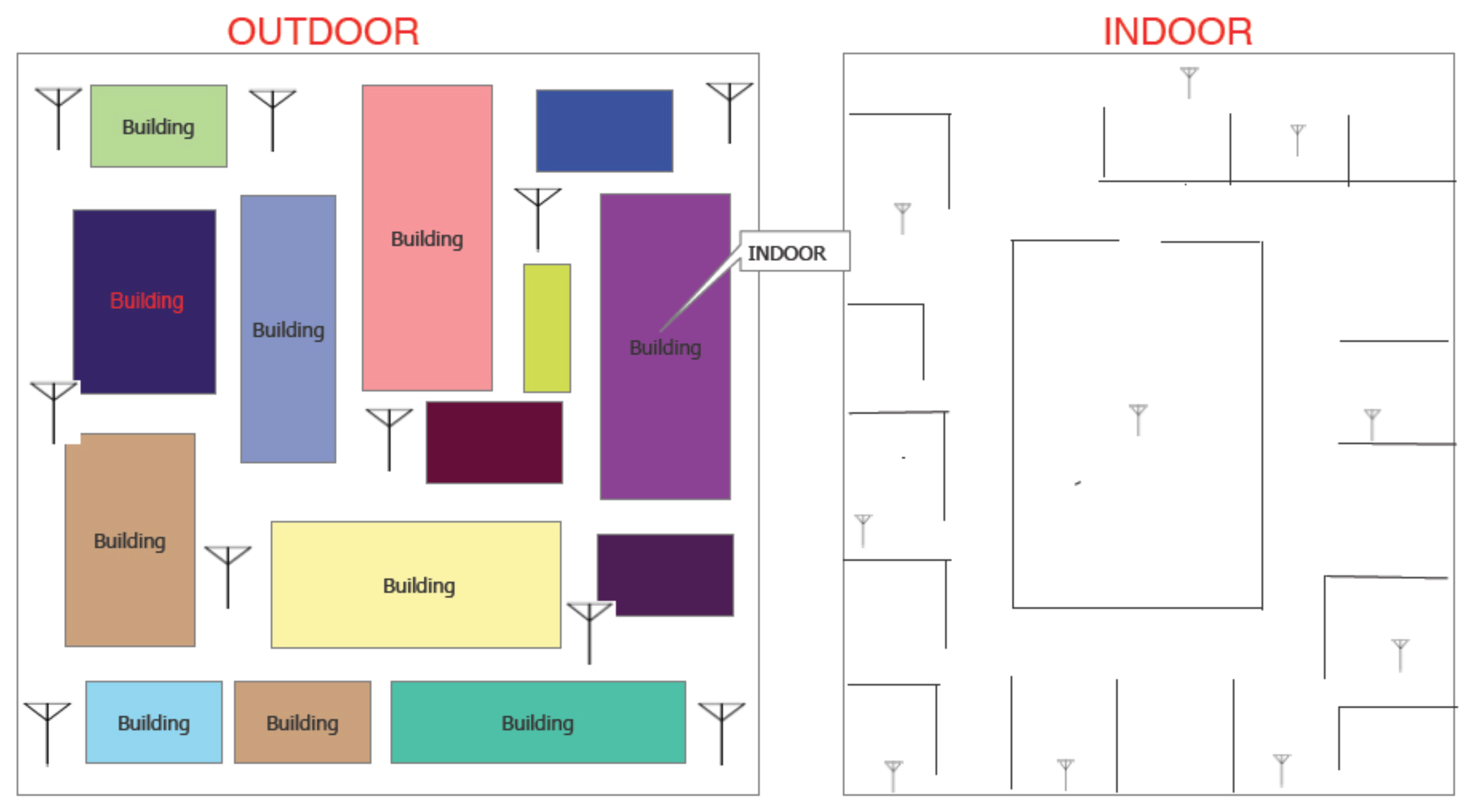
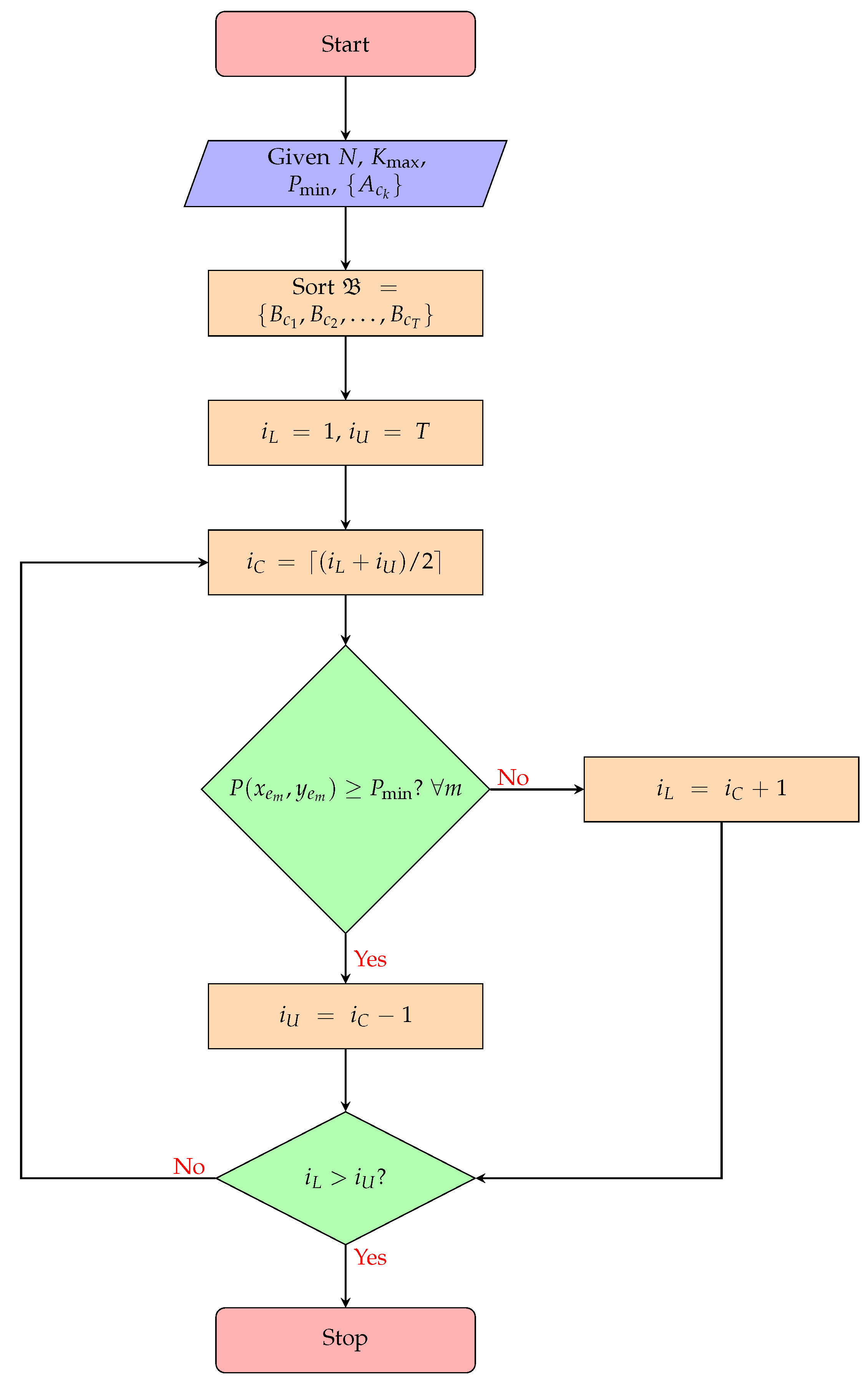

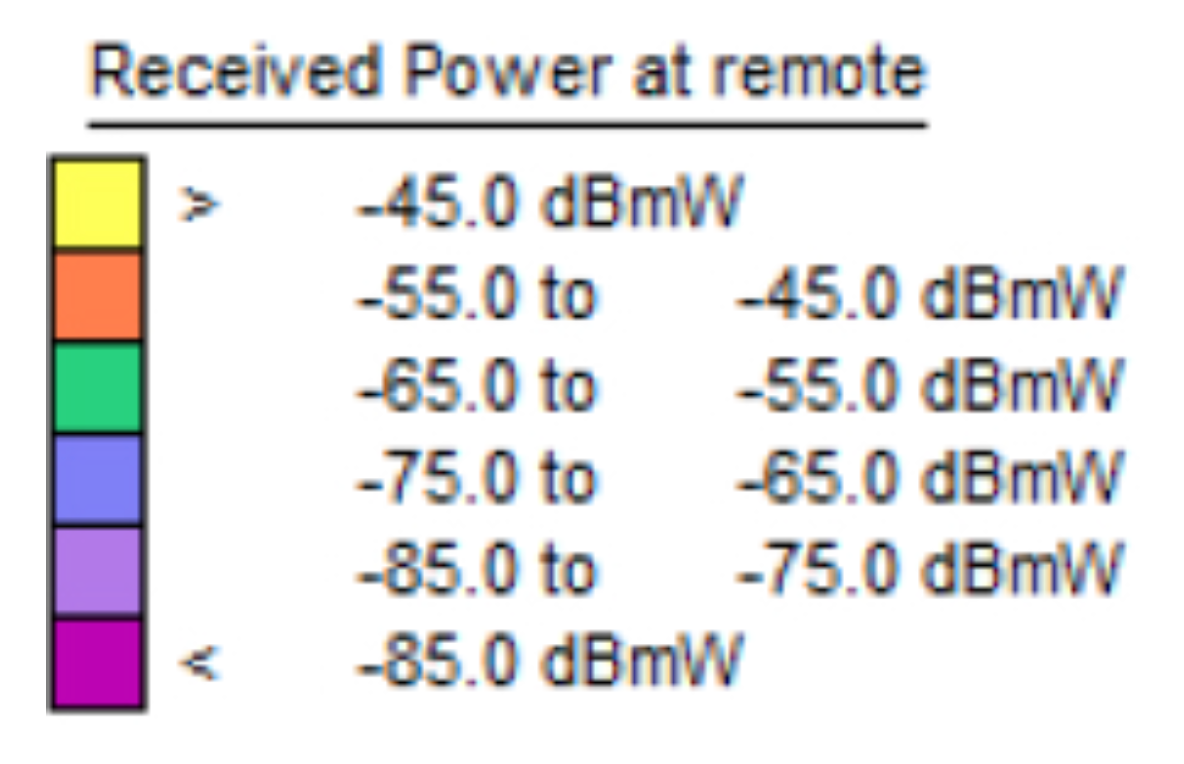
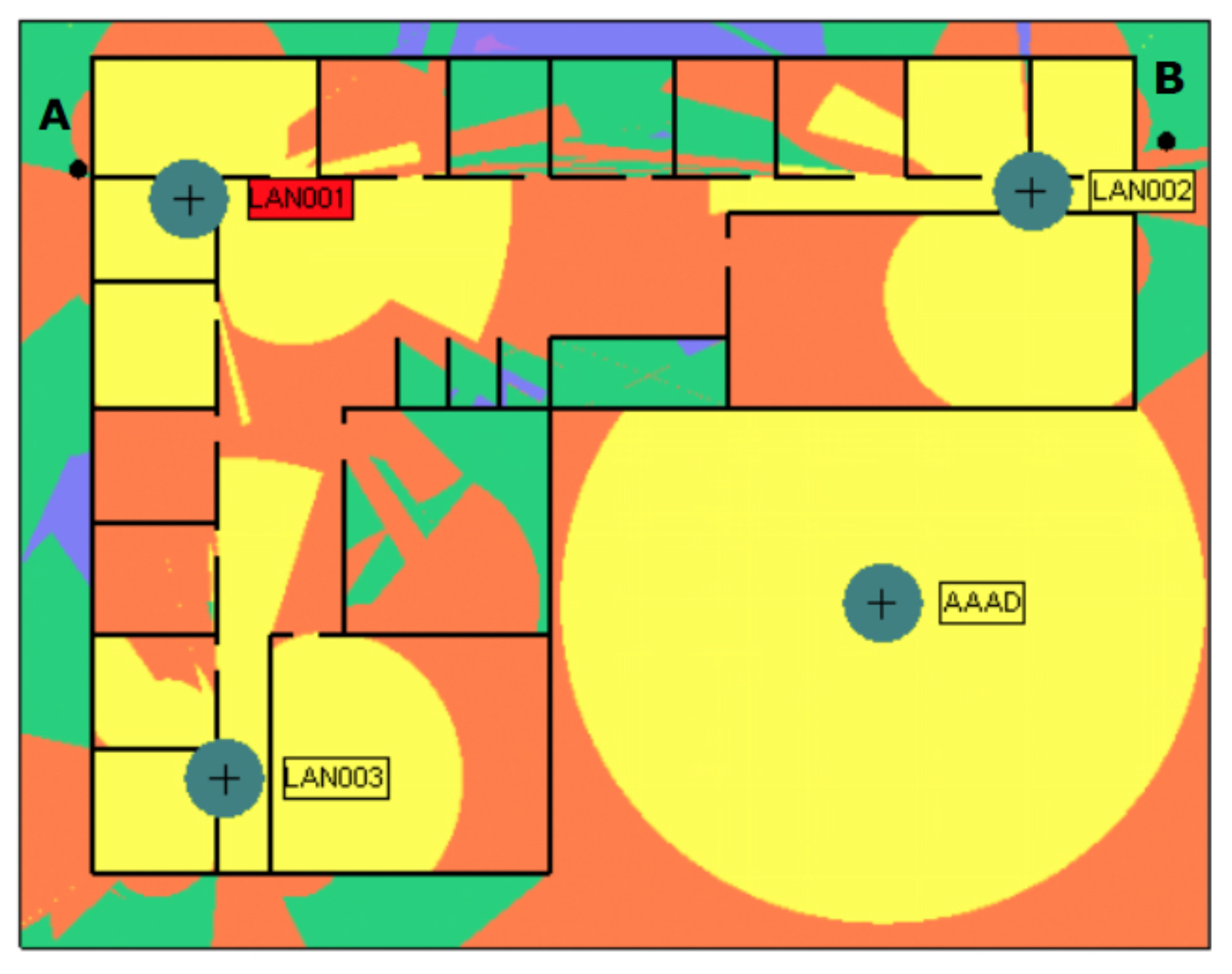

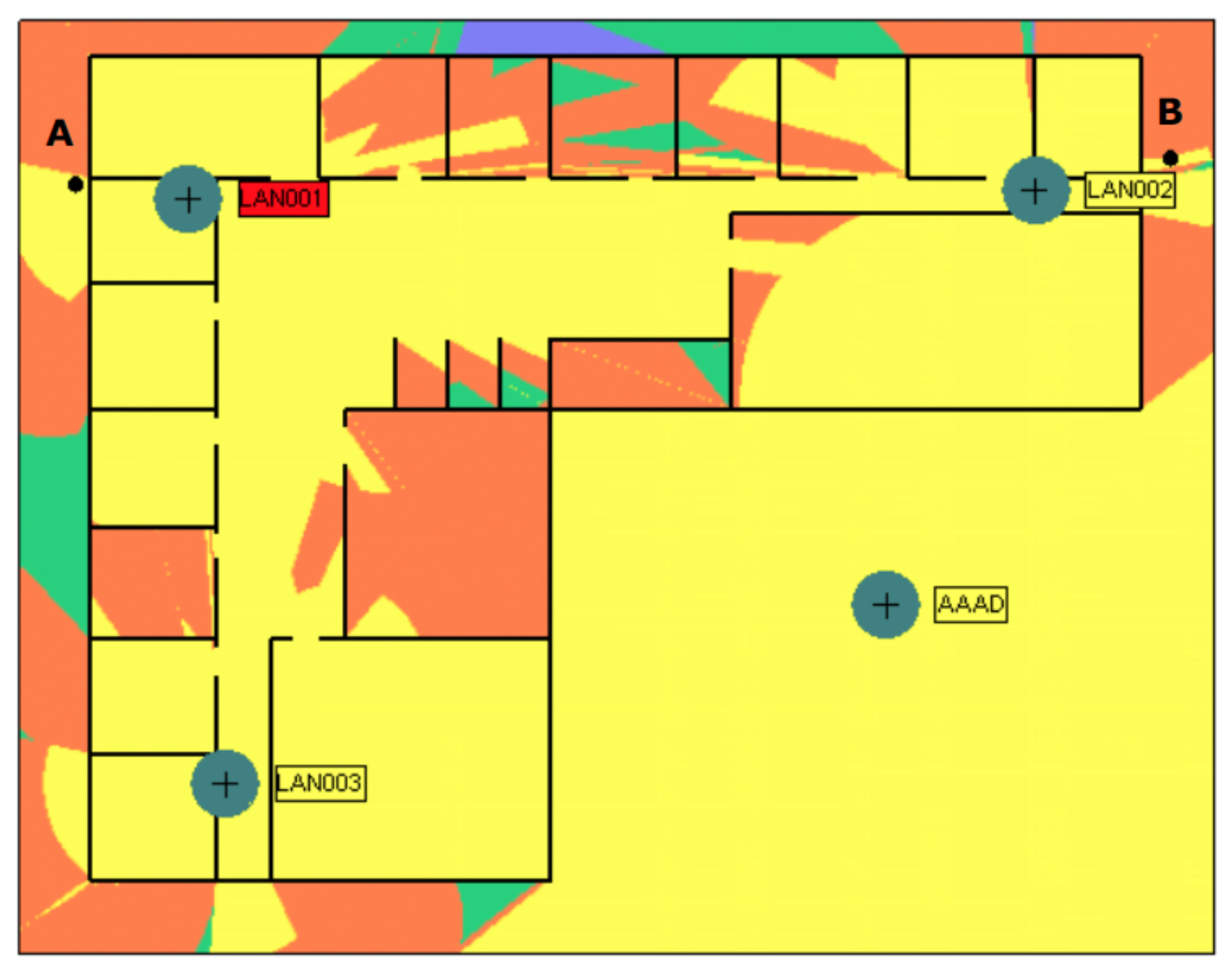
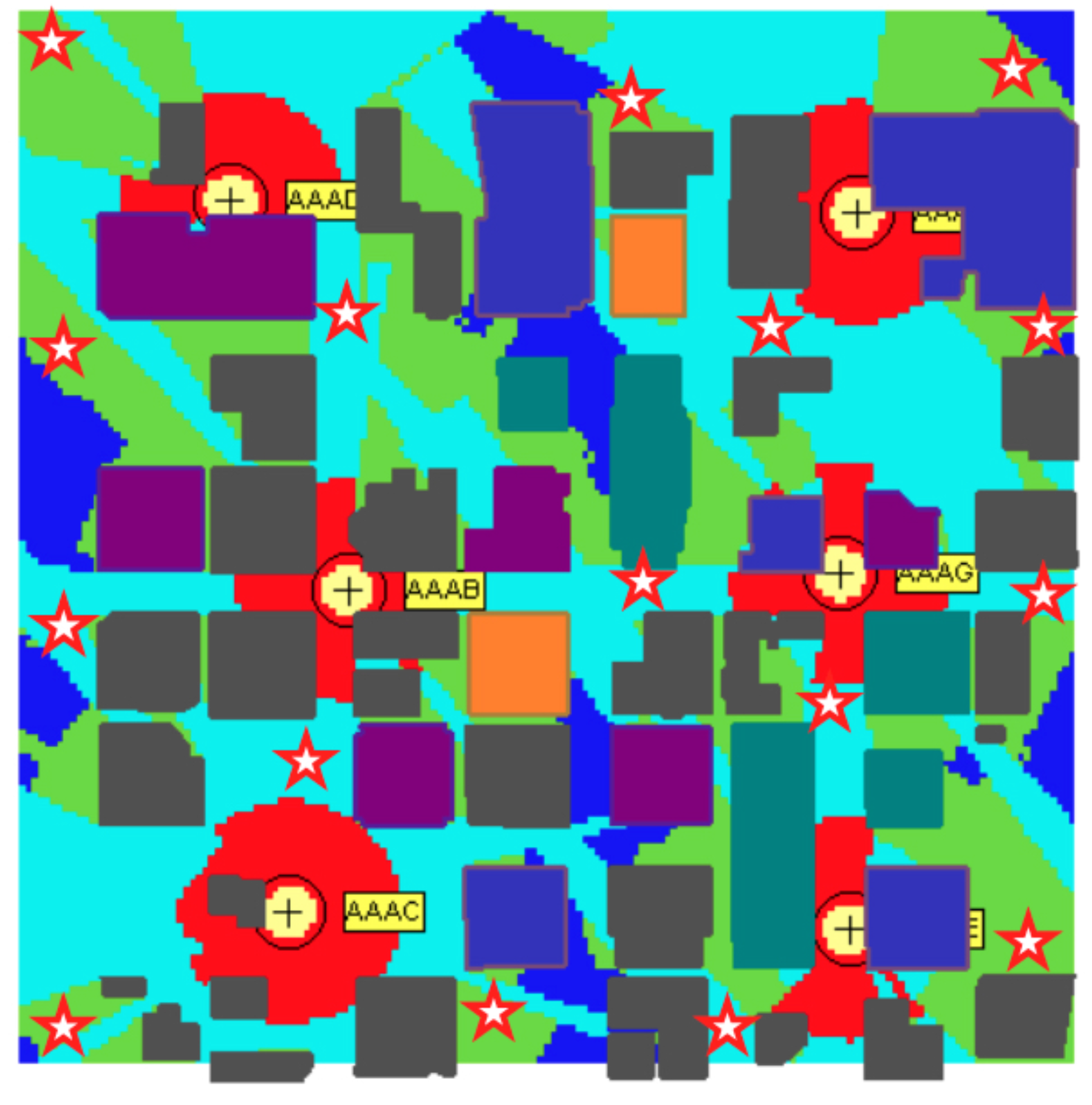
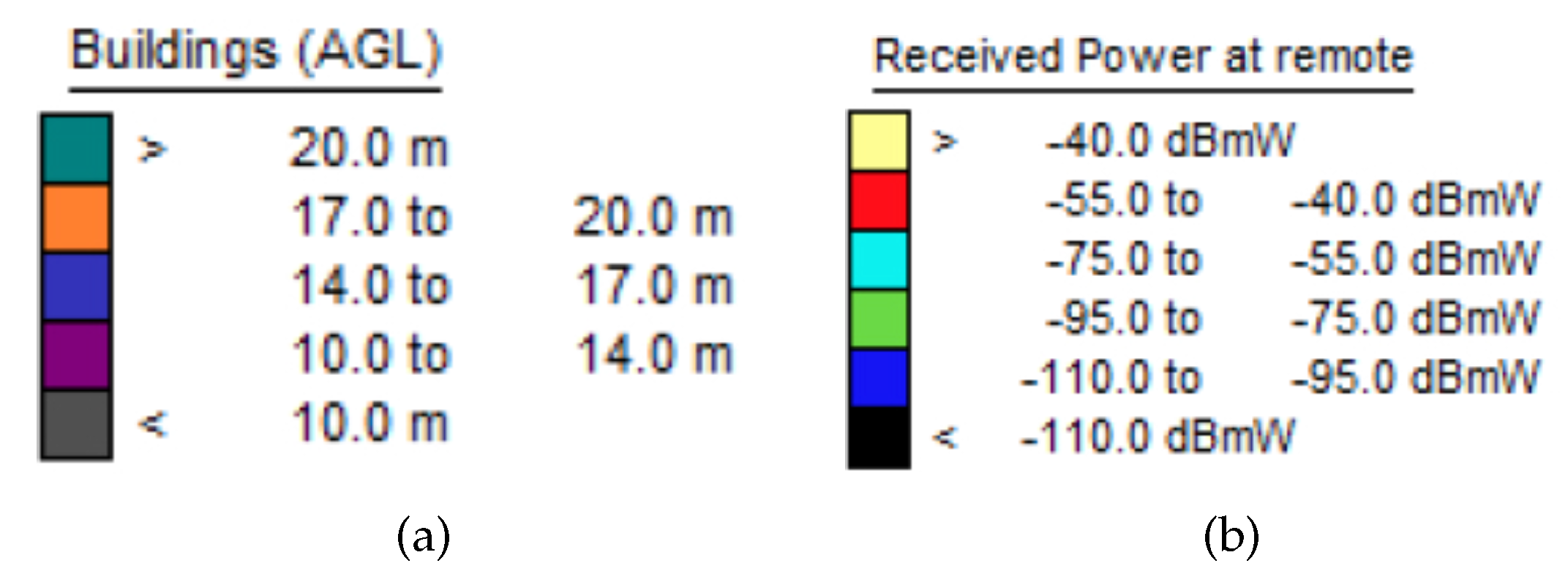
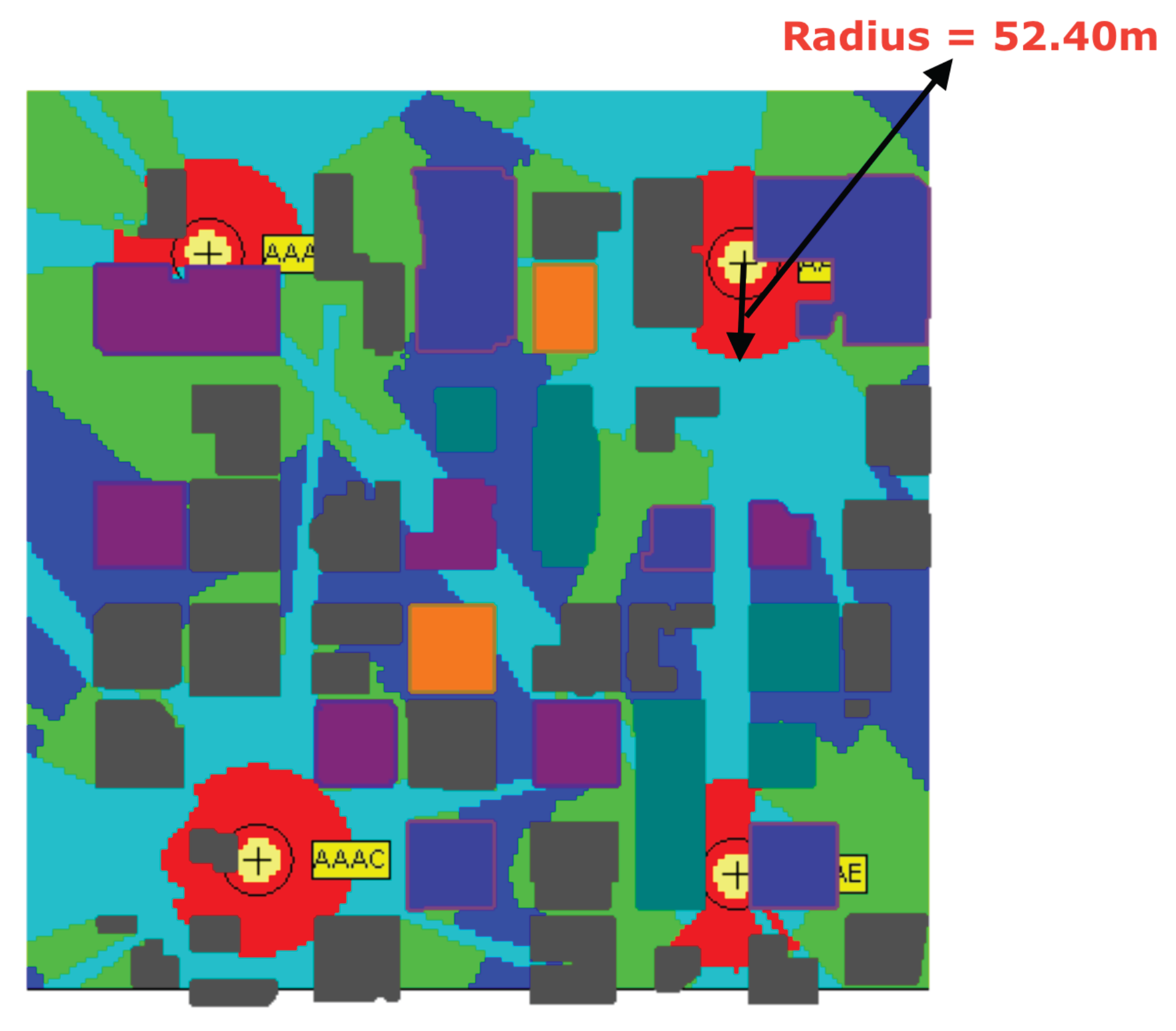


| RF Parameters at Transmitter of a Cell Site | Values/Description |
| Antenna pattern | omnidirectional isotropic |
| Antenna height | 3 m |
| Antenna polarization | horizontal |
| Cross polarization attenuation | 0 dB |
| Transmitter type | Wi-Fi 802-11a/g |
| Effective isotropic radiated power (EIRP) | dBm |
| RF Parameters at a Typical Receiver | Values/Description |
| Antenna pattern | omnidirectional isotropic |
| Antenna height | 2 m |
| Antenna polarization | vertical |
| Cross polarization attenuation | 15 dB |
| Receiver type | WiFi 802-11a/g |
| Receiver noise system noise figure | 4.0 dB |
| Receiver noise level | dBm |
| Equivalent receiver noise bandwidth | 20 MHz |
| Adjacent channel rejection | 40 dB |
| RF Parameters at Transmitter of Cell Sites | Values/Description |
| Antenna pattern | omnidirectional isotropic |
| Antenna height | 30 m |
| Antenna polarization | horizontal |
| Cross polarization attenuation | 0 dB |
| Transmitter frequency | 850 MHz |
| EIRP | dBW |
| RF Parameters at a Typical Receiver | Values/Description |
| Antenna pattern | omnidirectional isotropic |
| Antenna height | 2 m |
| Antenna polarization | horizontal |
| Cross polarization attenuation | 15 dB |
| Mobile type | cellular |
© 2017 by the authors. Licensee MDPI, Basel, Switzerland. This article is an open access article distributed under the terms and conditions of the Creative Commons Attribution (CC BY) license (http://creativecommons.org/licenses/by/4.0/).
Share and Cite
Omorinoye, A.A.; Vien, Q.-T. On the Optimisation of Practical Wireless Indoor and Outdoor Microcells Subject to QoS Constraints. Appl. Sci. 2017, 7, 948. https://doi.org/10.3390/app7090948
Omorinoye AA, Vien Q-T. On the Optimisation of Practical Wireless Indoor and Outdoor Microcells Subject to QoS Constraints. Applied Sciences. 2017; 7(9):948. https://doi.org/10.3390/app7090948
Chicago/Turabian StyleOmorinoye, Adeola Abraham, and Quoc-Tuan Vien. 2017. "On the Optimisation of Practical Wireless Indoor and Outdoor Microcells Subject to QoS Constraints" Applied Sciences 7, no. 9: 948. https://doi.org/10.3390/app7090948





